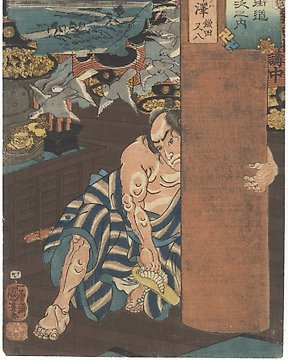
'Kamata Matahachi, Karuizawa' From: 'Sixty-nine Stations of Kisokaido Road' 木曽街道六十三次之内 軽井沢 鎌田又八 - Kuniyoshi Utagawa (1798- 1861) - Japan - Edo-perioden (1600-1868)
Nr. 83617143

Nr. 83617143

Good condition.
See Waseda University: https://archive.waseda.jp/archive/detail.html?arg={%22subDB_id%22:%2252%22,%22id%22:%22171926;1%22}&lang=en
One of the last great masters of ukiyo-e, Kunichika was inspired by the plays, actors and customs of kabuki theatre. His colourful prints are records of a long lost, decadent underworld of Edo. Since the beginning of the Meiji period, he made a large number of triptychs depicting half length portraits of a single actor on a big format and in luxurious style, applying original composition in this new design of dynamic prints. He got acclaimed for this work that improved the quality of half-length portraits and because those prints became known by their innovative composition, he succeeded in obtaining the full supremacy in the field of yakusha-e (actor prints).
His portrayal of human faces have some traces of his previous studies in hagoita style painting and can appear to be cold and hard, depending on the perspective, but it became a feature characteristic of his style.
Author:
Toyohara Kunichika (Japanese: 豊原 国周; 30 June 1835 – 1 July 1900) was a Japanese woodblock print artist. Talented as a child, at about thirteen he became a student of Tokyo's then-leading print maker, Utagawa Kunisada. His deep appreciation and knowledge of kabuki drama led to his production primarily of yakusha-e, which are woodblock prints of kabuki actors and scenes from popular plays of the time.
An alcoholic and womanizer, Kunichika also portrayed women deemed beautiful (bijinga), contemporary social life, and a few landscapes and historical scenes. He worked successfully in the Edo period, and carried those traditions into the Meiji period. To his contemporaries and now to some modern art historians, this has been seen as a significant achievement during a transitional period of great social and political change in Japan's history.
Sådan køber du hos Catawiki
1. Opdag noget særligt
2. Afgiv det højeste bud
3. Foretag en sikker betaling